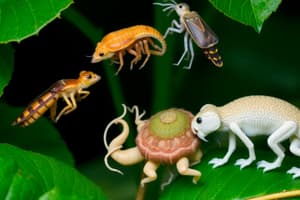Podcast
Questions and Answers
Organisms in the Animalia kingdom obtain energy through which of the following methods?
Organisms in the Animalia kingdom obtain energy through which of the following methods?
- Producing their own food from inorganic substances
- Photosynthesis
- Decomposing dead organisms
- Consuming other organisms (correct)
All organisms in the Fungi kingdom are multicellular
All organisms in the Fungi kingdom are multicellular
False (B)
What characteristic distinguishes Eubacteria cells from Animalia cells?
What characteristic distinguishes Eubacteria cells from Animalia cells?
Prokaryotic vs Eukaryotic
Organisms in the Plantae kingdom are classified as ________ because of their ability to perform photosynthesis.
Organisms in the Plantae kingdom are classified as ________ because of their ability to perform photosynthesis.
Match the following kingdoms with their primary cell type:
Match the following kingdoms with their primary cell type:
Which kingdom primarily consists of organisms that live in extreme environments, such as hot springs or highly saline waters?
Which kingdom primarily consists of organisms that live in extreme environments, such as hot springs or highly saline waters?
All protists are unicellular organisms.
All protists are unicellular organisms.
What term is used to describe animals' method of obtaining energy?
What term is used to describe animals' method of obtaining energy?
________ obtain food from breaking down dead organisms, acting as decomposers in the ecosystem.
________ obtain food from breaking down dead organisms, acting as decomposers in the ecosystem.
Eubacteria can be described as which of the following?
Eubacteria can be described as which of the following?
Flashcards
Animalia
Animalia
Kingdom containing multicellular eukaryotic organisms that obtain nutrients by ingestion; includes animals.
Plantae
Plantae
Kingdom consisting of multicellular, eukaryotic, photosynthetic organisms.
Archaebacteria
Archaebacteria
Prokaryotic organisms often found in extreme environments; one of the six kingdoms of life.
Fungi
Fungi
Signup and view all the flashcards
Eubacteria
Eubacteria
Signup and view all the flashcards
Protista
Protista
Signup and view all the flashcards
Animalia
Animalia
Signup and view all the flashcards
Plantae
Plantae
Signup and view all the flashcards
Fungi
Fungi
Signup and view all the flashcards
Protista
Protista
Signup and view all the flashcards
Study Notes
- There are six kingdoms of life: Animalia, Plantae, Fungi, Protista, Eubacteria, and Archaebacteria.
- Eubacteria and Archaebacteria were once classified as a single kingdom called Monera.
Animalia
- Contains all animals (multicellular).
- Composed of Eukaryotic Cells.
- Animals are heterotrophs, obtaining energy from outside sources as consumers.
Plantae
- Consist of multicellular organisms capable of photosynthesis (producers).
- Cells that compose plants are eukaryotic.
- "The Angel Oak" is the oldest oak tree in the southeastern United States.
Fungi
- Can be unicellular (one cell) or multicellular (made of many cells).
- Fungi are decomposers, acquiring food by breaking down dead organisms.
- Cells that make up Fungi are Eukaryotic.
Protista
- Organisms that do not classify as plants, animals, or fungi.
- Cells are eukaryotic.
- Can be unicellular or multicellular.
- Some are consumers (acquiring food by consuming other organisms) while others are producers (photosynthesis).
Eubacteria
- Cells are prokaryotic (without a nucleus).
- These are unicellular organisms.
- Can function as both producers and consumers.
- The most common bacteria found on Earth can be beneficial or harmful to humans.
Archaebacteria
- Cells are prokaryotic (without a nucleus).
- Consist of single-celled organisms (unicellular).
- Known as "ancient bacteria" and found in extreme environments (extremophiles).
- Three different types: Heat lovers, salt lovers, and methane gas makers.
Studying That Suits You
Use AI to generate personalized quizzes and flashcards to suit your learning preferences.




